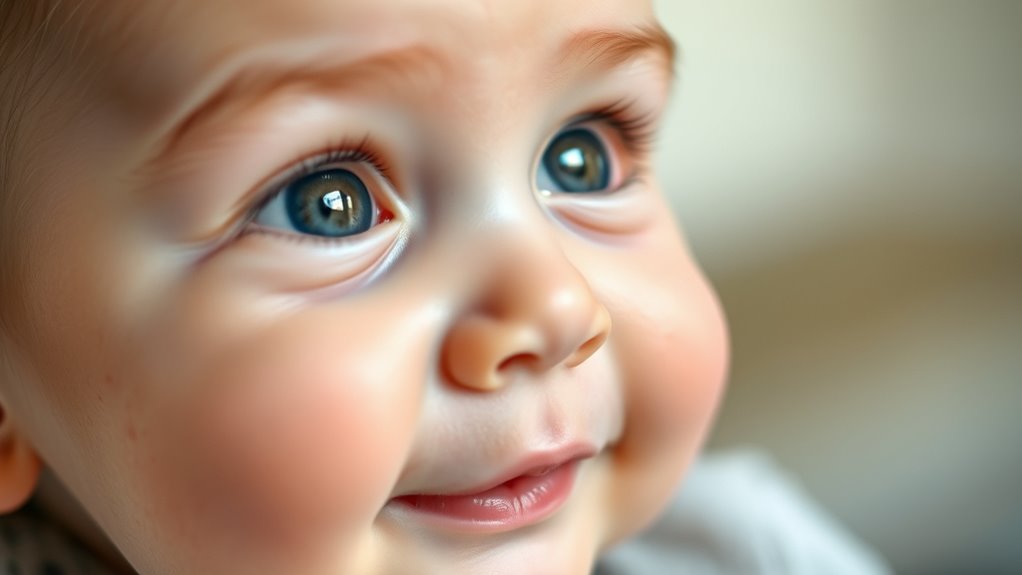Babies are naturally drawn to faces from birth because their brains are wired to prioritize them. Specialized neural circuits, like the fusiform face area, activate early, helping babies recognize familiar faces and form bonds. Neonatal responses focus on faces more than objects, supporting social and emotional development. Mirror neurons aid in understanding emotions through facial expressions. Keep exploring how these brain mechanisms shape your little one’s social connection and emotional growth.
Key Takeaways
- Babies are born with an innate, hardwired attraction to faces that supports early social bonding.
- Specialized brain regions like the fusiform face area are active from birth, enabling rapid face recognition.
- Early neural responses to faces are automatic, helping infants recognize caregivers and interpret emotional cues.
- Mirror neurons facilitate facial imitation and emotion understanding, fostering emotional development and empathy.
- Repeated exposure to faces strengthens neural pathways, enhancing social skills and emotional intelligence over time.
The Innate Attraction to Faces in Newborns
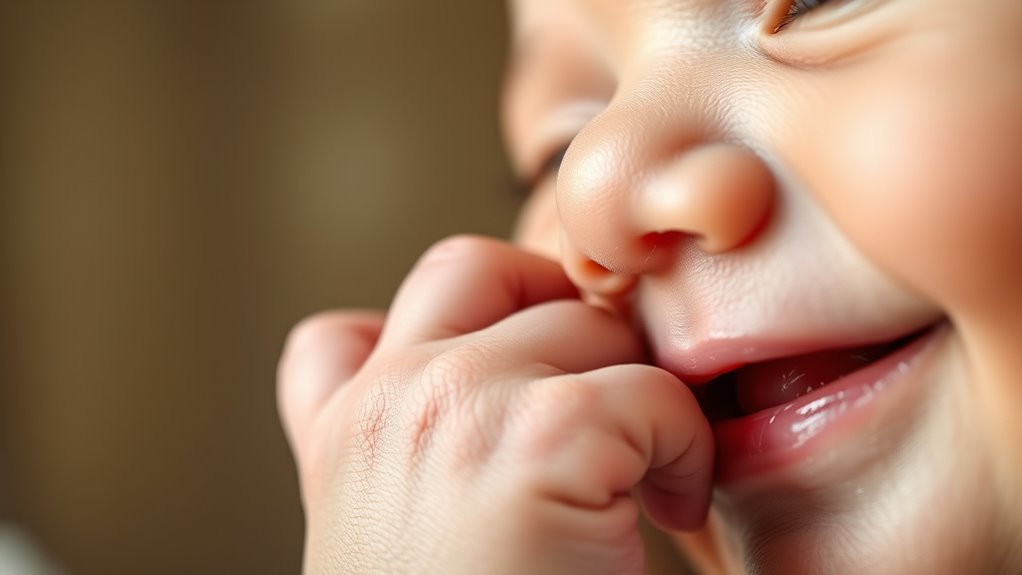
From the moment they are born, babies instinctively focus on faces, demonstrating an innate attraction that seems hardwired into their brains. This natural preference helps them recognize familiar caregivers and builds early social bonds. When you smile or look at your baby, they’re drawn to your face, noticing your eyes, mouth, and expressions. This focus isn’t learned; it’s part of their biological wiring, designed to promote attachment and communication. Researchers have observed newborns tracking faces with their eyes within hours of birth, showing an automatic attention to facial features. This early attraction acts as a foundation for social development, encouraging babies to seek interaction and learn about emotions. Your baby’s fascination with faces is an essential step in their understanding of human connection.
The Role of Specialized Brain Areas in Face Recognition
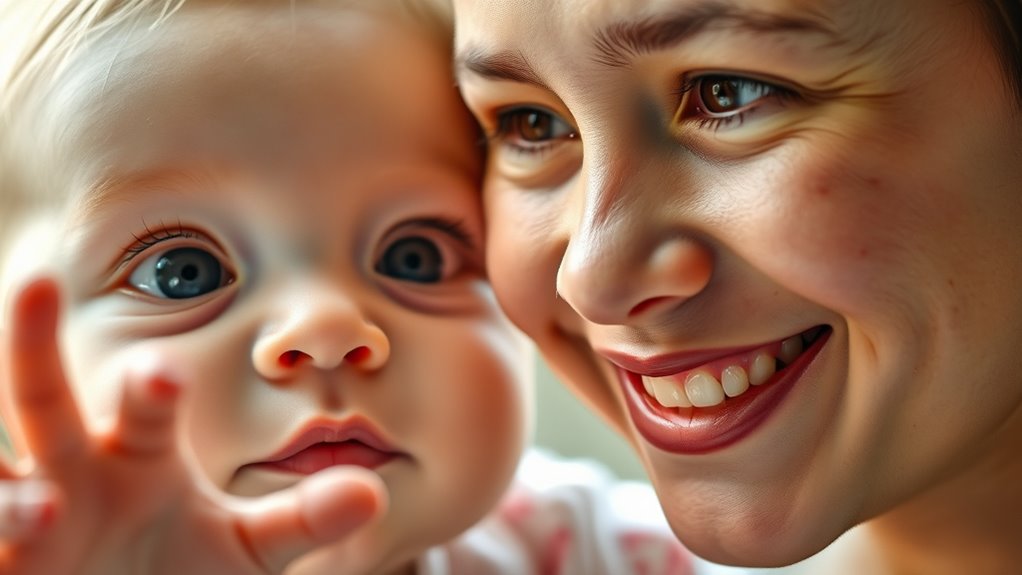
You can see that specific brain regions are dedicated to recognizing faces, even early in life. These areas develop through early neural specialization, making face recognition more efficient over time. Visual processing pathways direct the information to these specialized regions, enabling quick and accurate identification. Additionally, ongoing research suggests that remote work habits can influence brain function and cognitive flexibility, which may impact how these regions mature and adapt.
Face-Specific Brain Regions
Certain areas of the brain are specialized for recognizing faces, enabling you to quickly and accurately identify familiar individuals. The fusiform face area (FFA), located in the temporal lobe, plays a central role in this process. When you see a face, your FFA activates, helping you distinguish that face from others and recognize who it belongs to. Another key region is the occipital face area (OFA), which processes basic facial features like eyes, nose, and mouth. These regions work together seamlessly, allowing you to quickly interpret facial expressions and identities. Their specialization means your brain can process faces efficiently, even in complex or crowded environments. This neural setup explains why faces stand out so clearly and why babies are naturally drawn to them. Color accuracy and contrast ratios further enhance the visual clarity of faces, making them even more recognizable and engaging to the brain.
Early Neural Specialization
Have you ever wondered how newborns can recognize faces so quickly? Their brains show early neural specialization, meaning certain areas are wired from the start for face recognition. This specialization helps babies process faces more efficiently than other objects. Here are four key points:
- Innate wiring: Some brain regions are prepped for faces at birth.
- Rapid development: These areas become more refined with exposure.
- Selective attention: Babies focus more on faces than other stimuli early on.
- Neural tuning: Brain responses to faces strengthen over time.
- Additionally, *specialized brain areas* involved in face recognition demonstrate early activation, highlighting the importance of neural circuitry in social development.
This early neural focus promotes social bonding and learning, setting the foundation for recognizing familiar faces later. It’s a remarkable process showing how your baby’s brain is wired for social connection from day one.
Visual Processing Pathways
When it comes to recognizing faces, your brain relies on specialized visual processing pathways that route information through distinct areas designed for this purpose. The main route involves the fusiform face area (FFA), located in the temporal lobe, which is key for identifying faces quickly. Alongside the FFA, the occipital face area (OFA) processes basic facial features like eyes and mouth, helping your brain assemble a complete picture. These pathways work together, filtering visual input to distinguish faces from other objects. When you see a face, signals travel efficiently through these areas, enabling rapid recognition and emotional interpretation. This dedicated network explains why faces stand out to you and why babies are naturally drawn to them—they’re wired to process faces with remarkable sensitivity from a very early age. Additionally, the specialized neural circuits involved develop early in life, supporting infants’ innate attraction to faces.
How Neonatal Brain Responses Differ From Other Stimuli
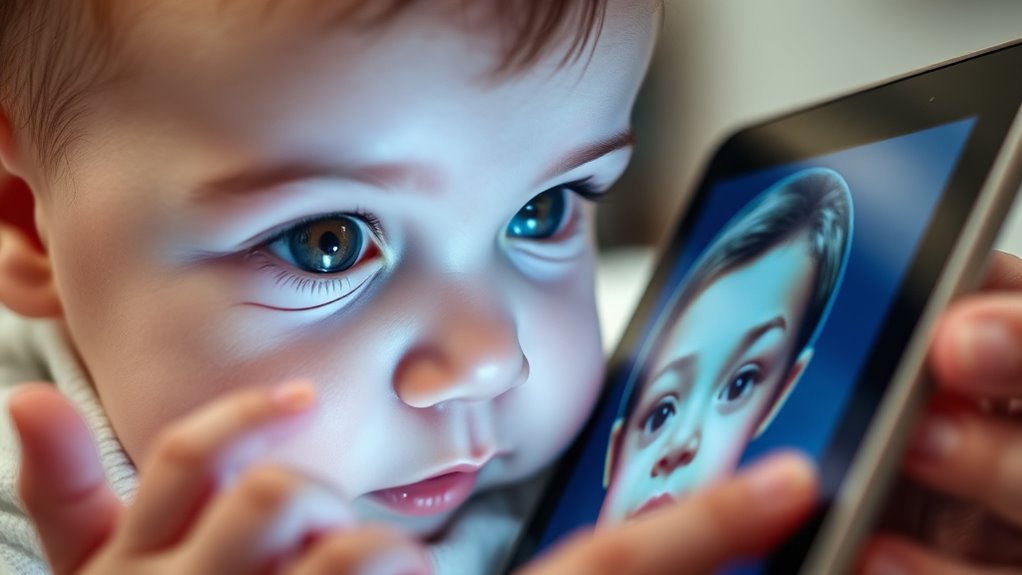
Neonatal brains respond to faces and babies in ways that set them apart from other types of stimuli. When you show a face, your baby’s brain activates specific regions more intensely than it does with objects or abstract patterns. This heightened response is due to:
- Specialized neural circuits tuned for face recognition
- Rapid processing of facial features like eyes and mouth
- Increased activity in areas linked to social connection
- Early sensitivity to emotional expressions
- Vetted by research, these neural responses are consistent across diverse populations and underscore the importance of faces for early social development.
These responses occur almost immediately after birth, highlighting that babies are wired to prioritize faces. Unlike other stimuli, faces trigger more synchronized and robust neural activity, emphasizing their importance for social bonding and development. This unique neural response underpins why babies are naturally drawn to faces from the very start.
The Development of the Fusiform Face Area
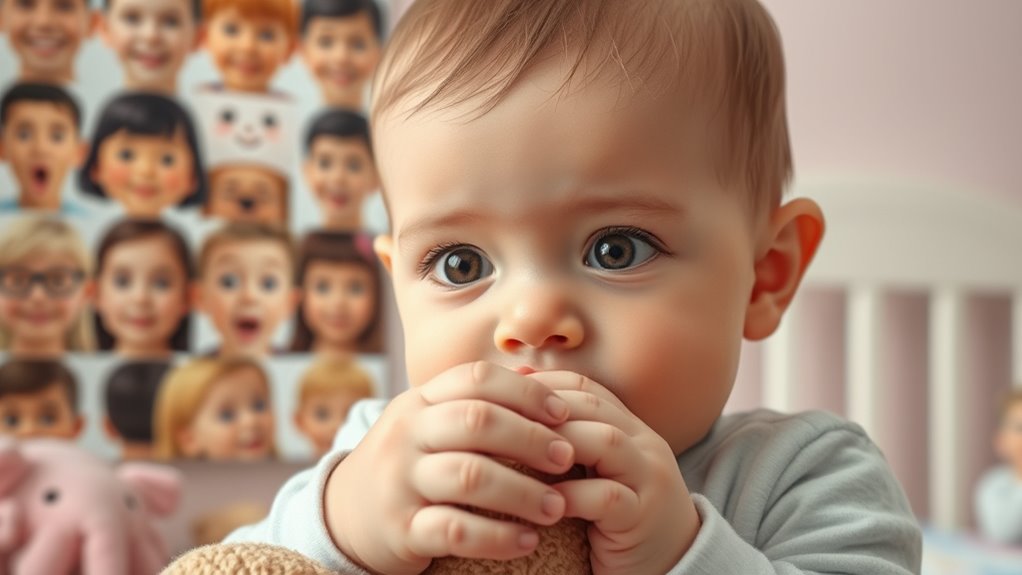
The fusiform face area (FFA) is a specialized region in the brain that becomes increasingly dedicated to face recognition as a person matures. When you’re a baby, this area isn’t fully developed, and your responses to faces are more generalized. Over time, exposure to many faces helps this region grow and specialize, making it easier for you to distinguish individual features. Your brain begins to recognize subtle differences, like a smile or eye shape, more efficiently. This development is driven by experience, shaping the neural circuits involved in face processing. As you get older, the FFA becomes finely tuned, allowing you to effortlessly identify familiar faces and interpret social cues. This process highlights how your brain adapts to social stimuli through maturation and experience. Additionally, research shows that neural development in the FFA continues well into adolescence, further refining your face recognition skills.
Neural Pathways Involved in Social Bonding
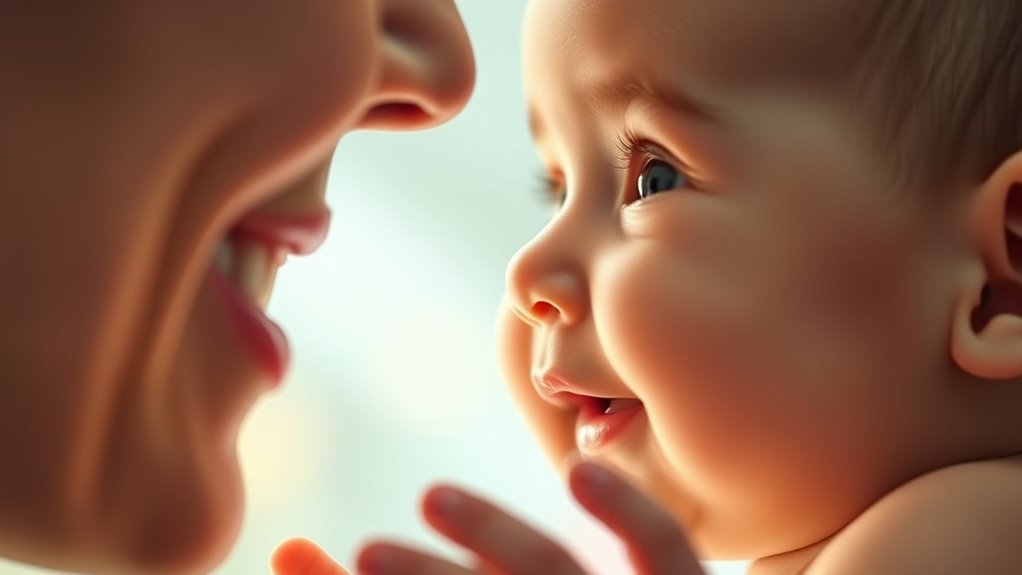
Social bonding relies on specific neural pathways that facilitate feelings of attachment, trust, and emotional connection. These pathways activate in response to social cues like faces, voice tones, and touch. Here’s what you should know:
- The oxytocin system promotes bonding by releasing this “love hormone” during close interactions.
- The dopaminergic reward pathway reinforces positive feelings associated with social contact.
- The amygdala processes emotional responses, helping you interpret facial expressions and social cues.
- The prefrontal cortex regulates social behavior and decision-making, fostering empathy and trust.
- The integration of these neural pathways is crucial for social bonding, enabling infants to form secure attachments that influence their emotional development.
The Impact of Early Experiences on Face Processing Skills

Early experiences play a crucial role in shaping your face processing skills, as your brain rapidly adapts to recognize and interpret facial features during infancy. The more you see faces—especially familiar ones—the stronger your ability becomes to distinguish emotions and identities. Positive interactions build confidence, while limited exposure can delay recognition skills. Your early environment influences how effectively you interpret social cues, impacting your emotional understanding later in life. Additionally, comfort solutions for sofa beds can help create a cozy environment that encourages positive interactions with caregivers.
Mirror Neurons and Emotional Recognition in Babies
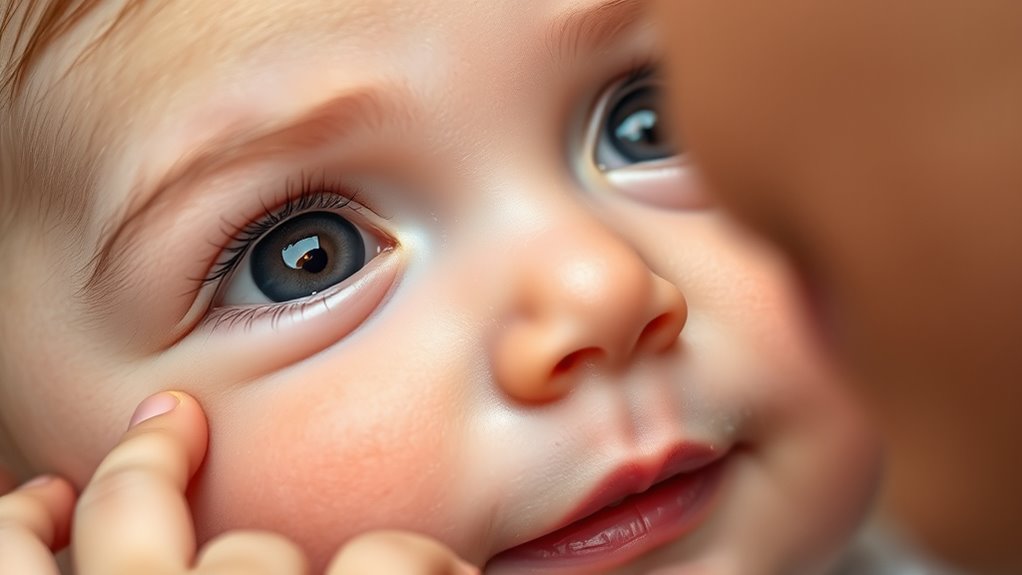
Mirror neurons are specialized brain cells that activate both when you perform an action and when you observe someone else doing the same thing, playing a key role in emotional recognition. In babies, these neurons help them understand and feel what others are experiencing. Here’s how they contribute:
- They enable babies to imitate facial expressions, fostering emotional connections.
- They help babies recognize emotions by matching observed expressions with internal feelings.
- They support empathy development, as babies learn to respond appropriately to others’ moods.
- They lay the groundwork for social learning by linking actions with emotional states.
The Connection Between Face Perception and Emotional Development

Recognizing faces is a fundamental skill that shapes emotional development from a young age. When you can interpret facial expressions, you learn to understand others’ feelings, which helps you respond appropriately. This skill fosters empathy, trust, and social bonding. For babies, seeing a familiar face with a happy or calm expression reassures them and promotes a sense of security. Over time, they begin to associate specific facial cues with emotions, developing emotional intelligence. These early experiences lay the groundwork for how you manage your feelings and interpret others’ emotions later in life. Face perception acts as a bridge between visual recognition and emotional understanding, enabling you to navigate social interactions with confidence. This connection is essential for your overall emotional health and social skills development. Understanding the importance of toilet flushing mechanisms can also reflect how environmental factors influence daily routines and health.
How Neuroscience Sheds Light on Infant-Caregiver Interactions
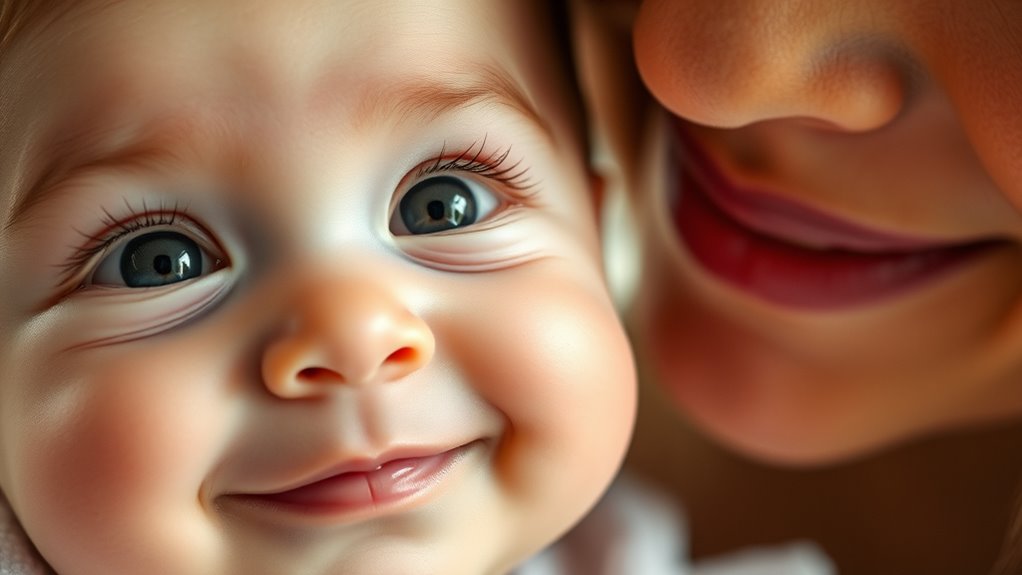
Neuroscience reveals how infants recognize and respond to faces, laying the foundation for strong bonds with caregivers. The mirror neuron system plays a key role, helping babies understand and imitate emotions they see. Together, these processes support emotional connection and attachment from the earliest interactions. Embrace Adventure in learning about infant development can provide valuable insights into fostering healthy relationships.
Face Recognition in Infants
Understanding how infants perceive faces reveals critical insights into their developing social skills and bonds with caregivers. Researchers find that even newborns can recognize familiar faces, showing preferences early on. Here’s what neuroscience uncovers about face recognition:
- Infants are born with a bias toward face-like patterns, helping them focus on caregivers.
- Their brains rapidly develop specialized areas, like the fusiform face area, for processing faces.
- Recognition improves as they grow, enabling differentiation between familiar and unfamiliar faces.
- Early face recognition skills support emotional bonding and social learning.
This ability lays the foundation for more complex social interactions, helping infants connect with those around them and understand social cues from a very young age.
Mirror Neuron System Role
The mirror neuron system plays a essential role in how infants connect with their caregivers by enabling them to internally simulate and interpret observed actions and emotions. When you see a caregiver smile or reach out, your mirror neurons activate, helping you understand and feel what’s happening. This internal mirroring lays the groundwork for social learning, allowing you to copy gestures, facial expressions, and behaviors. It also helps you recognize emotional states in others, fostering empathy and attachment. As your brain responds to these cues, you begin to build a shared understanding with your caregiver. This neural activity isn’t just passive; it actively shapes how you learn social skills, interpret intentions, and develop bonds, making face-to-face interactions profoundly meaningful.
Emotional Bond Formation
When your mirror neuron system becomes active during face-to-face interactions, it lays the foundation for forming strong emotional bonds with your caregiver. This process helps you understand and respond to their emotions, strengthening your connection. Neuroscience reveals four key ways this bond develops:
- Shared emotions: You mirror your caregiver’s feelings, creating mutual understanding.
- Contingent responses: Your responses become synchronized, reinforcing trust.
- Facial recognition: Recognizing familiar faces boosts emotional security.
- Attuned interactions: Consistent, responsive exchanges deepen attachment.
These neural mechanisms make your interactions meaningful, shaping your attachment style. As your brain continuously maps emotional cues, you learn to feel safe, loved, and understood, laying the groundwork for healthy relationships later in life.
Frequently Asked Questions
Can Babies Differentiate Between Familiar and Unfamiliar Faces Early On?
You might wonder if babies can tell familiar from unfamiliar faces early. The answer is yes; by just a few months old, babies start recognizing familiar faces through their gaze, attention, and preference. Their developing brains quickly process facial features, enabling them to distinguish loved ones from strangers. This ability helps build emotional bonds and promotes social learning, making face recognition a vital part of early development.
How Does Genetics Influence Infants’ Face Recognition Abilities?
Think of your baby’s face recognition like a treasure map, guided by genetics. Your child’s genes influence brain wiring, making some infants naturally better at distinguishing faces early on. For example, research shows genetic factors can impact the development of neural pathways tied to face processing. By around six months, these genetic influences help your baby recognize loved ones effortlessly, shaping their social world and emotional bonds.
Are There Differences in Face Perception Between Different Cultural Backgrounds?
You might notice that people from different cultures perceive faces differently. These differences stem from varied exposure to specific facial features and expressions. Your cultural background shapes how you interpret emotions and recognize familiar faces. While some aspects of face perception are universal, like recognizing basic emotions, others are influenced by cultural norms and practices. This variability enriches your understanding of social cues and enhances cross-cultural interactions.
How Do Visual Impairments Affect Newborns’ Face Processing Development?
You might wonder how visual impairments impact newborns’ face processing development. When babies have visual impairments, they often miss out on early exposure to faces, which can slow their ability to recognize and interpret facial cues. This delay may affect social interactions and emotional understanding. However, with early intervention and alternative sensory experiences, you can support their social and emotional growth despite visual challenges.
What Role Do Parents’ Facial Expressions Play in Infants’ Emotional Growth?
You might think that parents’ facial expressions are just reactions, but they actually shape your baby’s emotional growth. When you smile or show concern, you help your infant recognize emotions and build trust. These expressions provide essential cues, guiding your baby’s understanding of feelings and social interactions. By consistently showing warmth and responsiveness, you foster emotional security, helping your little one develop healthy emotional skills and strong bonds.
Conclusion
By understanding how your baby’s brain is wired to love faces, you see the gentle magic happening every day. It’s like planting tiny seeds of trust and connection, quietly shaping their future relationships. With your nurturing, those early glimpses of recognition blossom into deep bonds and emotional understanding. Remember, in every smile and glance, there’s a tender story unfolding—one that guides their world toward warmth, trust, and endless discovery.
